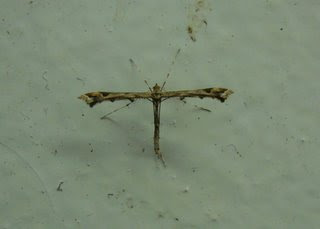Four of the 15 new species recorded in 2011: Peach, Blossom, Elephant Hawkmoth, Leopard Moth and Purple Bar
The year got off to quite a good start with
Mottled Umber and
Winter Moth both turning up on January 2nd, but that was it until March 22nd when
Double-striped Pug was recorded, these three moths were the only species noted in the first quarter of the year. Things started to pick up in April with five species recorded;
Herald on the 11th, and
Brindled Pug on the 12th, then nothing until
Waved Umber on the 21st followed by
Common Marbled Carpet and
Pale Prominent, both on the 25th. May was the most prolific month with 26 species recorded;
Brimstone Moth on the 2nd,
Small Dusty Wave and
Figure of Eighty both on the 6th then
White-spotted Pug, Mottled Pug, Green Carpet and
Bright-line Brown-eye all on the 10th; a
Cinnabar turned up on the 12th along with the first of 15 new species for the station, a pristine
Purple Bar. Things then slowed down for a few days until a
Riband Wave on the 16th followed by
Pale Tussock, Pale Mottled Willow and, for the third year running,
Toadflax Brocade, all on the 17th,
Common Pug turned up on the 18th,
Snout and
Small Fan-foot on the 19th,
Willow Beauty and
Buff Ermine on the 22nd,
White Ermine on the 23rd and
Angle Shades on the 24th. Then nothing until the 30th when
Least Carpet and
Treble Brown Spot turned up, the month finished in a rush with
Small Blood-vein, Single-dotted Wave, Dwarf Cream Wave and
Barred Straw all on the 31st. Five new species for the station turned up in June,
Oligia agg. on the 2nd,
Oak Nycteoline on the 16th,
Pheonix on the 22nd,
Foxglove Pug on the 23rd and
Leopard Moth on the 27th; another 12 species were recorded during the month;
Garden Carpet and
Yellow Shell on the 5th,
Common Footman on the 8th,
Blotched Emerald on the 12th,
Uncertain on the 14th,
Lime-speck Pug on the 16th,
Dun-bar on the 21st,
Common Emerald on the 22nd,
Brown Silver-line on the 23rd,
Heart & Dart on the 26th,
Scalloped Oak on the 27th and
Clay on the 29th. July also produced five new species for the station;
Peach Blossom on the 14th,
Scarce Footman on the 21st
, Tree-lichen Beauty on the 27th,
Lunar-spotted Pinion on the 29th and
Elephant Hawkmoth on the 30th
. Freyer's Pug, Early Thorn and
Silver Y all turned up on July 1st followed by
Marbled Beauty on the 3rd with
Dingy Footman and
Small Ranunculus on the 5th, the second year in a row that this recent re-colonist has turned up at the station.
Common Wainscot appeared on the 10th followed by
Olive on the 14th,
Dusky Sallow on the 22nd,
Ruby Tiger on the 25th,
Dark Spinach on the 26th and
Swallow-tailed Moth and
Cloaked Minor, both on the 30th. There were only five additions in August and no statiion firsts;
Straw Dot on the 2nd,
Yellow-barred Brindle on the 8th,
Lesser Yellow Underwing on the 9th,
Shuttle-shaped Dart on the 11th and
Small Fan-footed Wave on the 26th.
September was a suprisingly good month with two station firsts;
Centre-barred Sallow on the 9th and
Juniper Pug on the 16th; six more species were recorded,
Turnip Moth on the 1st,
Square-spot Rustic and
Vine's Rustic, both on the 2nd,
Large Ranunculus on the 19th,
Flounced Rustic on the 22nd and
Lunar Underwing on the 23rd; by contrast
Pink-barred Sallow on the 3rd was the only new species recorded during October. The last two months of the year are usually very unproductive but this year both months contributed station firsts;
Scarce Umber on November 24th
and
Red-line Quaker n December 22nd. Finally two other stations on the commute both added moths not recorded at Berrylands,
Maiden's Blush on April 20th and
Grey Pug on May 6th, both at Earlsfield with
Chocolate Tip on May 6th and
Broad-barred White on June 24th at Raynes Park.




















